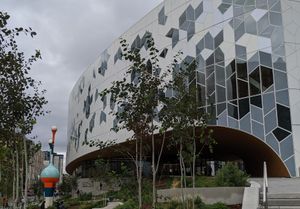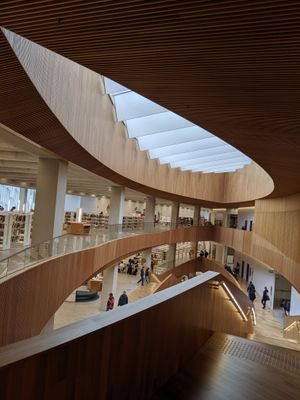I mentioned the reworked University of Michigan Libraries website a while ago.
Although it is still a layer over various other resources, I liked the way that the site aimed to project the library on the web as a unified service not as a set of unrelated opportunities. This extended to the way that links to specialist library advice was included alongside the other resources. [Lorcan Dempsey’s weblog – A web-siting at the University of Michigan]
For reasons discussed in these pages many times this layering is not straightforward:
This is largely because they are providing a thin layer over two sets of heterogeneous resources. One is the set of legacy and emerging systems, developed independently rather than as part of an overall library experience, with different fulfillment options, different metadata models, and so on (integrated library system, resolver, knowledge base, repositories, …). Another is the set of legacy database and repository boundaries that map more to historically evolved publisher configurations and business decisions than to user needs or behaviors (for example, metadata, e-Journals, eBooks, and other types of content, which may be difficult to slice and dice in useful ways). [Lorcan Dempsey’s Weblog – Stitching costs]
There is a blog entry by Ken Varnum providing a high level overview of design decisions:
Implemented in Drupal with Solr to power our search results, the site integrates what was a varied and highly decentralized network of library web pages. We pruned and weeded the roughly 100,000 pages on the old site – many of which were leftovers from past redesigns – into about 7,000 pages and 13,000 resource entries. We also introduced powerful new discovery tools for our patrons. [[BLT] Blog for library technology – The New University of Michigan Library Web Site]
I particularly like the way a search in the home-page search box gives back a range of results, including a match to a subject expert if this is possible. They try to put, literally, a ‘human face’ on the results page.
The catalog search itself is a VuFind deployment, and article search talks to Metalib’s x-server, dropping you into Metalib if you request it (I think – I am not an authorized user so can only go so far).
I think the Michigan site does a very nice job in projecting the library service and trying to abstract the user experience away from the underlying database and service boundaries it is managing. Of course, as a ‘tourist’ I cannot follow trails into resources I am not authorised to use.
Recently, I was directed to the new Libraries website at Miami University. This is on a smaller scale and there is a ‘thinner’ integration layer over the site as a whole. But, again, I liked the fact that the design goal seems to be to project the library as a unified service offering, carrying navigation and appearance as consistently as it could between parts.
In terms of presentation, I was interested to see some things in common between the sites. They each use Libguides to assemble web-based resources in particular subject areas (including links to pictured library staff). This enhances the sense of the pages as a professionally curated resource, and seems to support better overall UI consistency. Another was the use of Drupal and Solr. And another was the deployment of a separate interface to the native ILS catalog, VuFind in Michigan’s case and (I think) MULtifacet in Miami’s.
MULtifacet is a Drupal 5 module that wraps a UI around an arbitrary Solr index. It shares many features with other Solr-based OPAC projects, including faceted search results, SMS/email output, RefWorks integration, user tagging, saving/exporting of records, RSS feeds, Zotero support, Google Books images/linking, “more like this”, formatted citation output (via the WorldCat API), COinS, unAPI, etc. While developed for, and initially targeted at, library collections, there’s no reason it couldn’t put a UI on other Solr indexes that need similar features. [MULtifacet]
I had begun this entry when I was interested to see a related discussion emerge on the WEB4LIB list. Tim Spalding asked if anybody was aware of a library website where the various solutions looked as if they were part of the same organic whole. David Walker responded by pointing to the library website at CalPoly.
And as library websites go, it is indeed very nice. I noticed again that Libguides play a part, and am interested to see that you can browse by both subject area and by librarian (‘people are entry points‘).
Even though the website is increasingly a part only of how the library projects its network services, it is important to improve how it does so.
Related entries:



